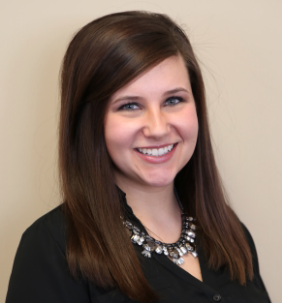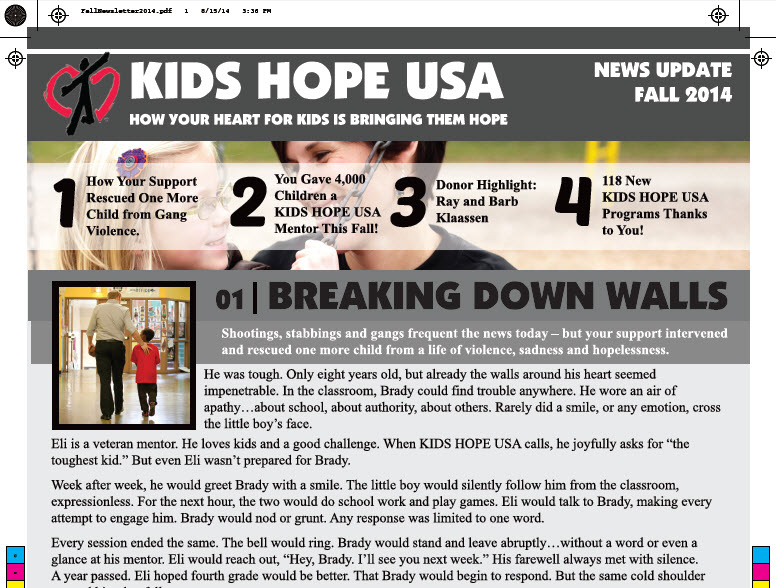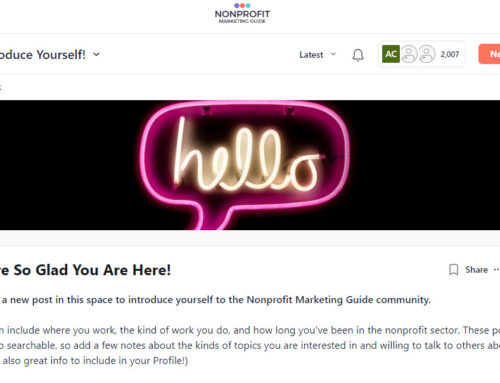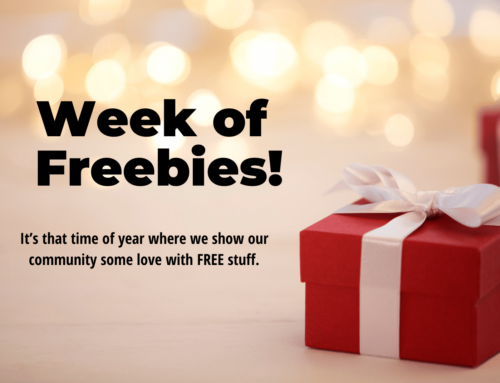
Theresa Casey
One of my favorite parts of my job is coaching young communications directors. I love the enthusiasm and willingness to experiment that 20-somethings usually bring to this work. But part of the job — as you’ll see in our guest post today — is also giving them the cold, hard reality check that comes from having worked in this field for nearly as long as they have been alive.
That part often does not go over so well . . . Except when it’s someone like Theresa Casey of Kids Hope USA. Theresa is a gem . . . she has the backbone to stand up for what she really believes is important, and the flexibility to embrace suggestions, even some that are personally tough to swallow. That’s what she’s done with her newsletter — and I can’t wait to see what happens with her upcoming year-end appeal!
Here’s Theresa’s take on some of our conversations about her newsletter — she describes it as a story on the value of listening, and how it made her newsletter more successful. ~Kivi
Guest Post by Theresa Casey of Kids Hope USA
There are many things that I was born naturally good at.
Eating, for instance. I love to eat!
Choosing an outfit for the day. Black on black on grey. Done!
Hugging my husband and my dog. Can’t this be a job?
Listening to others. Mmm… not so much.
That being said, I don’t think I’m alone. I truly feel that the number of individuals who are born good listeners are few and far between. Listening is a skill that takes time, effort, and completely goes against our human nature. After all, we are the most important character in our “life movie,” right?
Wrong! The truth is, if you ever want to become an excellent communicator, you have to learn to listen. This applies in every area of a non-profit communicator’s day-to-day. We listen to donors, we listen to programs, we listen to volunteers, we listen to our bosses. The real test, though, is what we do with what we hear.
A great exercise, and test to your ability to listen, comes from those who give you advice. They are the ones who are weathered in your area of profession. The ones who oversee your department. The ones that are sometimes the most difficult people to listen to.
However, I promise you that if you do listen with a teachable ear, beautiful things will come from it.
Don’t believe me? Fine. I’ll show you.
I present, the first-ever, Kids Hope USA Donor Newsletter. The scene takes place in the Spring of 2014 – newbie nonprofit communicator, Theresa Casey (myself) sits in angst in her office, frustrated beyond recognition by what a newsletter is supposed to be.
“I know I’m supposed to do it… but how??” I thought in my head, and then grumbled to my peers.
Flash forward to Summer 2014. The newsletter went out, and guess what? It did yield some money! It wasn’t much, but it covered the cost of the letter being sent out to close to 700 individuals, plus a little more.
“This is good,” Theresa thought, “But could it be better?”
Into the picture steps Kivi, confident that YES, in fact, Kids Hope USA’s Donor Newsletter could be better. It can make more money. And she told me exactly how.
Now, I’ll be honest, advice from an expert like Kivi is not always easy to swallow. She’s honest, straightforward and sometimes crushes your “but-wait-I’m-an-excited-creative” dreams. But the truth is, being an excited creative isn’t my job. Making money so that more at-risk children can be reached with a mentor – that is my job. So I listened.
Just six weeks ago, Kids Hope USA sent out their second ever Donor Newsletter. It followed Kivi’s advice and guidelines. And guess what…
This newsletter brought in $4,000 more than the first newsletter. Almost four times as much money! If that isn’t proof that this “Listen to Kivi” stuff works, I don’t know what is!

So what exactly did Kivi suggest that made this Donor Newsletter so successful? Here’s the breakdown of what she told me:
1. Stop talking about yourself!
Our stories were full of information we wanted our donors (or audience) to hear. It wasn’t information that our donors wanted to hear. In Kivi’s words, “You have to cover the broccoli with lots of cheese!” We had to deliberately choose stories that our donors would find valuable, as opposed to forcing information down their throats.
2. You failed the “You” test!
In the initial newsletter, we really liked talking about ourselves. But let’s face it, do donors seriously care about the new Kids Hope USA strategic direction? No! They care about the at-risk children that their gifts are reaching! And they want to hear about it! So this time around, we made sure that the word “you” was practically in every other sentence in our newsletter.
“How your support rescued one more child from gang violence.”
“Thanks to your generosity, the ‘End of the School Year’ matching campaign raised $17,602.”
“Your support continues to spur areas of accelerated program growth…”
3. Highlight the Donor!
Yes, we really took that to heart! Instead of highlighting our staff or our accomplishments, we literally chose a donor and highlighted their story and why they chose to support Kids Hope USA. They are the ones who make our work possible, so why not give them the spotlight?
These are some of the big takeaways that I learned from Kivi, but they are not all of them. When it comes to becoming a donor-centric writer, there is always something to learn – and there are always experts to listen to.
Take a moment to realize that whether we are a nonprofit newbie full of new ideas, or a communications veteran who knows it all, that we are never exempt from learning, improving and in the end, making a huge difference in the world through our work in the non-profit world.
Carry on, Difference Makers! And don’t forget to listen!
Theresa Casey is a very new nonprofit communicator (just about 8 months) and fundraiser for Kids Hope USA, a national nonprofit based in Zeeland, Michigan. A Grand Valley State University grad, she received her degree in Public Relations/Advertising and worked a rigorous sales job for a year before entering the nonprofit sector. She loves the communications and fundraising world, and you can easily become her best friend with a cup of coffee and some good conversation.






